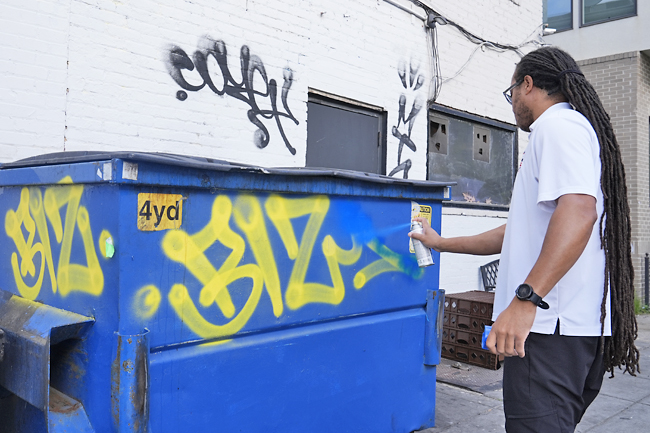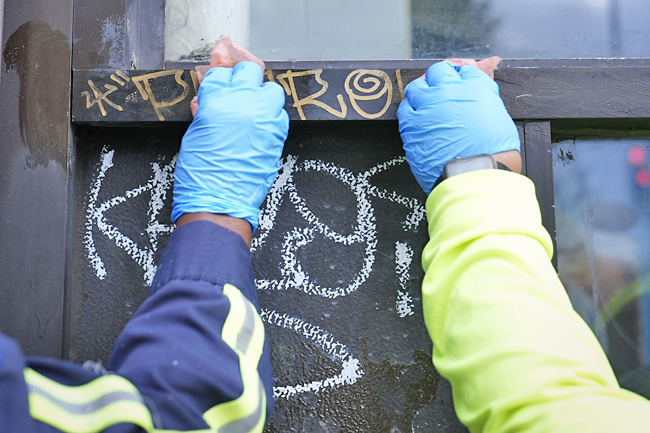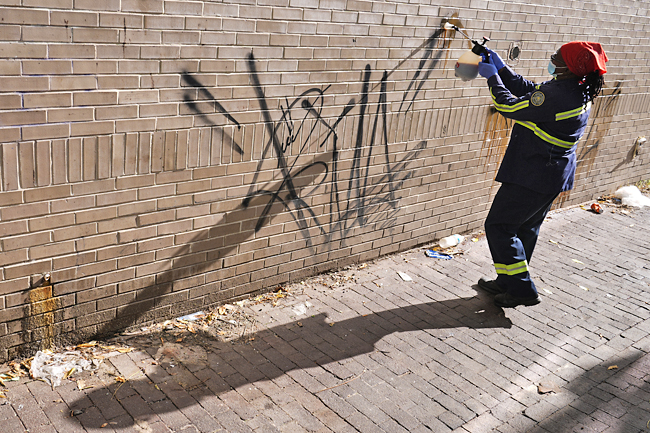WASHINGTON (AP) – U Street is mostly deserted when Aceba Broadus and his three-person crew from the District of Columbia’s Department of Public Works (DPW) start setting up shop before 8am at one of DC’s perennial graffiti hot spots.
They tap a hydrant to fill the 275-gallon tank in their truck and get to work – coating graffiti-covered walls with a special chemical and then blasting them with high-pressure water. The work progresses quickly, but Broadus holds few illusions that their efforts will last long.
“Come back on Friday and it will be all retagged again,” he said. “It’s definitely a bit frustrating.”
Across town, Eric B Ricks is engaged in his own graffiti project, far different from the tags and protest slogans often found on buildings and monuments across the nation’s capital. Using a scissor lift, Ricks applies a coat of primer to the wall of Savoy Elementary School in preparation for what will become a city-sponsored mural of geometric patterns and multicoloured birds.
“Graffiti is different for every practitioner of the craft. It’s like a hydra, this multiheaded thing that’s many things to many people,” said a longtime graffiti artist Ricks. “Graffiti in its purest form is like a flower growing out of filth and muck.”



This eye-of-the-beholder dynamic between vandalism and urban art form has been a reality since the earliest days of graffiti. One person’s artistic expression is another’s problematic eyesore. At any given time, there are three DPW removal teams working, and the city budgets USD550,000 per year for the task.
Those teams use a variety of methods, depending on the type of paint and material of the wall – limestone is the hardest to clean. Sometimes, they use gray paint to simply cover the graffiti on metal security doors. Some types of stone get a special chemical and the water hose. And occasionally, they need to call in outside contractors with a sandblaster.
The district also has to contend with political graffiti often left by the frequent mass protests that are drawn to the nation’s capital.
Most recently, the large protest against the Israel-Gaza war peaked with a takeover of Columbus Circle in front of Union Station, the Amtrak and commuter rail station. The protesters left graffiti throughout the area, including on a replica of the Liberty Bell.
One protester sprayed slogans on the statue of Christopher Columbus. That protest actually produced a rare graffiti-related arrest as authorities later charged a 20-year-old Maryland woman.
But mostly it’s tagging, the distinctive stylised bubble-letter signatures that can be seen on hundreds of buildings and all along the Metro train lines.
A 21-year DPW veteran, Broadus has become intimately familiar with some of the regular taggers. Three different times, young graffiti artists have been sentenced to community service on his crew; he has occasionally tasked a tagger with covering over their own work.
“I ask them why they do it, and they usually say something like, ‘We want to promote our name’,” Broadus said with a shrug.
For Ricks, that inability to grasp the motivation has been there since the earliest days of the modern graffiti movement – something he tracks to the early 1980s in New York City.
“Most people don’t understand why these kids are doing this,” he said. “Not everybody with a spray can has the same motivations and goals.”




